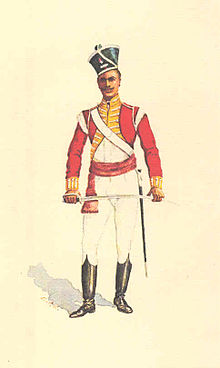Causes of the Indian Rebellion of 1857
The author Pramod Nayar points out that by 1851 there were nineteen Protestant religious societies operating in India, and their goal was the conversion of Indians to Christianity.
For instance, once the rebellion was underway, Mughal Emperor Bahadur Shah Zafar met the sepoys on 11 May 1857, he was told: "We have joined hands to protect our religion and our faith."
As further evidence, he observes that the Urdu sources of the pre rebellion and post-rebellion periods usually refer to the British not as angrez (the English), goras (whites) or firangis (foreigners) but as kafir (disbeliever) and nasrani (Christians).
[5] Some historians have suggested that the impact of British economic and social reforms has been greatly exaggerated, since the Company did not have the resources to enforce them, meaning that away from Calcutta their effect was negligible.
This seems to have been a very important reason for the spread of the rebellion, keeping in view the speed at which they ignited in many villages in northern India where farmers rushed to get back their former title deeds.
The company had an unbroken series of victories in India, against the Marathas, Mysore, north Indian states, and the Gurkhas, later against the Sikhs, and further afield in China and Burma.
Though paid marginally less than the Bombay and Madras Presidency troops, there was a tradition of trust between the soldiery and the establishment — the soldiers felt needed and that the company would care for their welfare.
This meant that when they came to be threatened by modernizing regimes in Calcutta, from the 1840s onwards, the sepoys had become accustomed to very high ritual status, and were extremely sensitive to suggestions that their caste might be polluted.
In 1824, there was another mutiny by a regiment ordered overseas in the First Anglo-Burmese War, who were refused transport to carry individual cooking vessels and told to share communal pots.
At other times however, the Company directly or indirectly conceded the legitimacy of the sepoy's demands, such as when troops of the Bengal and Madras armies refused to serve in Sindh without batta after its conquest.
[16] The varying stances of the British government, the reduction of allowances, and harsh punishments, contributed to a feeling amongst the troops that the Company no longer cared for them.
[17] At the beginning of the nineteenth century, British officers were generally closely involved with their troops, speaking Indian languages fluently; participating in local culture through such practices as having regimental flags and weapons blessed by Brahman priests; and frequently having native mistresses.
[18] Officers of an evangelical persuasion in the company's Army (such as Herbert Edwardes and Colonel S.G. Wheler of the 34th Bengal Infantry) had taken to preaching to their Sepoys in the hope of converting them to Christianity.
The serving high-caste sepoys were fearful that this requirement would be eventually extended to them, violating observance of the kala pani prohibition on sea travel.
Following the disarming and disbandment of an additional seventeen Bengal Native Infantry regiments, which were suspected of planning mutiny, only twelve survived to serve in the new post-mutiny army.
Once the first rebellions took place, it was clear to most British commanders that the grievances which led to them were felt throughout the Bengal army and no Indian unit could wholly be trusted, although many officers continued to vouch for their men's loyalty, even in the face of captured correspondence indicating their intention to rebel.
One thing did not change in this new weapon — the loading process, which did not improve significantly until the introduction of breech loaders and metallic, one-piece cartridges a few decades later.
The sepoys rejected this, pointing out that they might very well forget and bite the cartridge, not surprising given the extensive drilling that allowed 19th century British and Indian troops to fire three to four rounds per minute.
The musketry books also recommended that, "Whenever the grease around the bullet appears to be melted away, or otherwise removed from the cartridge, the sides of the bullet should be wetted in the mouth before putting it into the barrel; the saliva will serve the purpose of grease for the time being" This meant that biting a musket cartridge was second nature to the Sepoys, some of whom had decades of service in the company's army, and who had been doing musket drill for every day of their service.
Leader of the British Conservative Party and future prime minister Benjamin Disraeli argued these objects were signs to rebel and evidence of a conspiracy, and the press echoed this belief.

